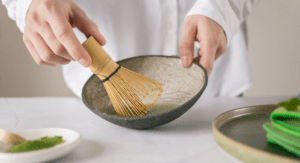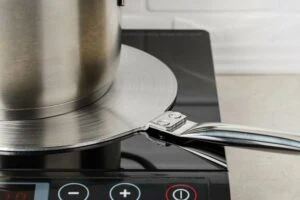A T-bone steak can be cooked in an oven or in a cast-iron skillet. These are the most common methods. However, you can just as easily pan-fry your T-bone steak in a regular frying pan.
According to USDA Institutional Meat Purchase Specifications, T-bone steaks should be at least 1/2 inch thick at the widest point. That description should add, “and devilishly delicious whichever way you cook it.” This brings us to the issue of the day – how to cook T-bone steak in frying pan.
Tips on Cooking T-Bone Steak in a Frying Pan
Ingredients
- T-Bone steak
- Black pepper
- Kosher salt
- Herbs of your choice
- Butter
- Cooking oil
Note: The ingredients you use will fully depend on your specific main dish recipe, so don’t feel confined by the options offered here.
Step 1: Prepare the Pan and Steak
When cooking T-bone steak in a frying pan, it’s advisable to use thinner cuts. This way, the meat has a better chance of cooking thoroughly on each side. Keep in mind that T-bones tend to be thicker cuts in general. If you want to cook a juicy steak, you can use cuts 1 1/2 inches to about 2 inches thick.
It’s also advisable to get fresh cuts because they taste better. While you can defrost any T-bone steaks you have in your freezer, nothing beats the fresh variety. Now see if the steak in your hand is moist. If it is, pat the steak dry with a paper towel before cooking it. This will ensure that you get a beautiful brown crust on the steak as it cooks.
Step 2: Season the Steak
This is where personal preference comes into play. You can season the steak with anything you like, including a host of herbs. However, if you are going to use salt and pepper, you need to do so just before cooking the steak. If you let the meat sit too long with salt on it, it will begin to draw moisture from the atmosphere, and this will negate the patting down that you did earlier.
Another option is to marinate the meat well in advance of cooking. If you are going to do this, you need to use a glass container or a plastic bag. Using any marinade of your choice, fully cover or lather the meat in the marinade, then place it in the glass container or bag and let it sit in the fridge for about two hours.
Let the meat sit in the marinade overnight to achieve the best results. However, if your marinade has alcohol, acid, or salt in it, don’t let it sit for more than 4 hours, as these ingredients will denature the meat.
Should you happen to use a marinade with citrus (lemon or lime), do not let the meat sit in it for more than two hours, as the citrus will change the color of the meat.
Step 3: Let the Steak Reach Room Temperature
This step is only necessary if you marinated your steak and put it in the fridge for two hours or more. Allow the steak to come to room temperature before you cook it. Remove your steak from the fridge about 50–60 minutes before you start cooking it. This is particularly important if you are using a thicker cut. Letting it come to room temperature allows the T-bone steak to cook thoroughly and consistently.
Step 4: Prepare the Pan
Now, since we are using a regular frying pan here and not a cast-iron skillet, it’s advisable to choose the heaviest option available to you. These heavy stainless steel frying pans can retain heat almost as well as heavy cast iron skillets.
Heat retention is necessary for the meat to cook through and achieve that even browning that makes T-bone steaks look good. Depending on how many steaks you want to cook at a time, you can choose a small or a much larger frying pan. Don’t crowd the pan because you will need to move the steaks around and flip them as necessary.
Once you have chosen your pan, put it on the stove and let it sit on high heat for a while. After a few seconds (about 15 or so), add about two tablespoons of vegetable oil and swirl the pan around until the pan is evenly coated with the oil.
Continue heating the pan until it’s hot enough to start slightly smoking. You want a screaming hot pan whenever you make steaks to achieve that brown and golden crust on the outside.
You can use olive oil if you want, but it is better to use oil with a high smoke point. Some olive oil varieties have low smoke points, resulting in a bad flavor when cooking steak.
Step 5: Add the T-Bone Steak to the Pan
Once your pan starts smoking, it’s time to add your T-bone steak and let it cook until it becomes deep brown. Use your meat thermometer to watch the steak’s internal temperature. According to the U.S. Department of Health and Human Services, the steak should be cooked to a minimum of 145 degrees Fahrenheit to be safe to eat.
However, if you prefer a medium rare pan-seared steak, you should pull it from the pan once the internal temperature hits 120 degrees Fahrenheit and 130 degrees Fahrenheit internal temperature for medium.
Pulling the steak from the pan at these respective temperatures will allow the meat to keep cooking with carryover heat without necessarily overcooking the steak. This entire process should take about 12 minutes, which means that you should flip the steak over at the 6-minute mark to achieve the perfect pan-seared steak.
If you are big on flavors when cooking steak, you can introduce butter, garlic, and any other desired herbs during the final two minutes of the cooking process. This is something we have seen Gordon Ramsay do a time or two.
Once you are satisfied that the T-bone steak has reached your desired doneness, pull it from the pan and place your perfect steak on a plate to rest. Cover it loosely with foil for about 10 minutes before you serve it. Always be sure to slice against the grain.












